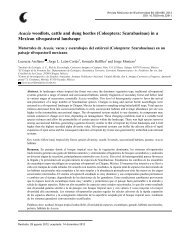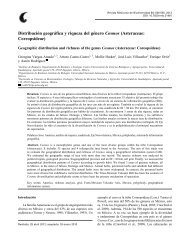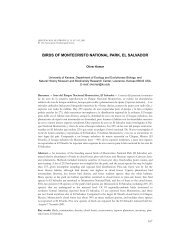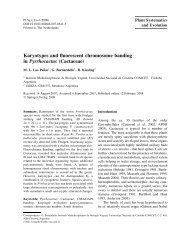First record of a neonate California sea lion (Zalophus californianus ...
First record of a neonate California sea lion (Zalophus californianus ...
First record of a neonate California sea lion (Zalophus californianus ...
- No tags were found...
You also want an ePaper? Increase the reach of your titles
YUMPU automatically turns print PDFs into web optimized ePapers that Google loves.
708 Ortega-Ortiz et al.- Neonate <strong>California</strong> <strong>sea</strong> <strong>lion</strong> in Manzanillo, ColimaFigure 3. Annual <strong>sea</strong> surface temperature (SST) values for thearea around La Boquita beach, Manzanillo, Colima, Mexico,<strong>record</strong>ed by the CEUNIVO-ICMB oceanographic buoy.for female <strong>California</strong> <strong>sea</strong> <strong>lion</strong>s make extralimital birthsimportant, highlighting the importance <strong>of</strong> monitoring the<strong>sea</strong>reas. Monitoring activities will increase the knowledgeregarding range and travel patterns <strong>of</strong> individuals and willprovide new elements for the species conservation andstatus analysis.We kindly acknowledge La Boquita beach fishermenand the staff at the “Enramada El Rey”; to PROFEPA,and the staff <strong>of</strong> Instituto Oceanográfico del Pacífico (IOP-Secretaría de Marina) for providing information regardingthe sighting. The Comisión Federal de Electricidadprovided economic support for marine mammal monitoringin the region. The University <strong>of</strong> Colima provided logisticsupport. The <strong>neonate</strong> assessment was conducted underpermit SGPA/DGVS/00447/11.Literature citedCarretta, J. V., K. A. Forney, M. M. Muto, J. Barlow, J. Baker,B. Hanson and M. S. Lowry. 2007. U.S. Pacific marinemammal stock assessments: 2006. Technical memorandumNOAA-TM-NMFS-SWSC.Ceballos, G., S. Pompa, E. Espinoza and A. García. 2010.Extralimital distribution <strong>of</strong> Galapagos (<strong>Zalophus</strong> wollebaeki)and Northern (Eumetopias jubatus) Sea Lions in Mexico.Aquatic Mammals 36:188-194.Feldkamp, S. D. 1987. Swimming in the <strong>California</strong> <strong>sea</strong> <strong>lion</strong>morphometrics,drag and energetics. Journal <strong>of</strong> ExperimentalBiology 131:117-135.Gallo-Reynoso, J. P. and A. Ortega-Ojeda. 1986. The first report<strong>of</strong> <strong>Zalophus</strong> <strong>californianus</strong> in Acapulco, México. MarineMammal Science 2:158.Gallo-Reynoso, J. P. and J. L. Solorzano-Velasco. 1991. Twonew sightings <strong>of</strong> <strong>California</strong> <strong>sea</strong> <strong>lion</strong>s on the southern coast<strong>of</strong> México. Marine Mammal Science 7:96.García-Aguilar, M. and D. Aurioles-Gamboa. 2003. Cuidadomaterno en el lobo marino de <strong>California</strong> (<strong>Zalophus</strong><strong>californianus</strong>) de Los Islotes, Golfo de <strong>California</strong>, México.Ciencias Marinas 29:573-583.García-Rodríguez, F. J. and D. Aurioles-Gamboa. 2004. Spatialand temporal variation in the diet <strong>of</strong> the <strong>California</strong> <strong>sea</strong> <strong>lion</strong>(<strong>Zalophus</strong> <strong>californianus</strong>) in the Gulf <strong>of</strong> <strong>California</strong>, Mexico.Fishery Bulletin 102:47-62.Hernández-Camacho, C., D. Aurioles-Gamboa and L. Gerber.2008. Age-specific birth rates <strong>of</strong> <strong>California</strong> <strong>sea</strong> <strong>lion</strong>s(<strong>Zalophus</strong> <strong>californianus</strong>) in the Gulf <strong>of</strong> <strong>California</strong>, Mexico.Marine Mammal Science 24:664-676.Kuhn, C. E., D. Aurioles-Gamboa and D. P. Costa. 2004. Habitatutilization, diving and foraging behavior <strong>of</strong> adult female<strong>California</strong> <strong>sea</strong> <strong>lion</strong>s (<strong>Zalophus</strong> <strong>californianus</strong>). XXIX ReuniónInternacional para el Estudio de los Mamíferos Marinos(SOMEMMA), 2-5 de mayo. La Paz, Baja <strong>California</strong> Sur,México.Le Boeuf, B. J. and D. E. Croker. 2005. Ocean climate and <strong>sea</strong>lcondition. BMC Biology 3:9.Lowry, M. S. and O. Maravilla-Chávez. 2005. Proceedings <strong>of</strong>the Sixth <strong>California</strong> Islands Symposium, Ventura, <strong>California</strong>,December 1-3, 2003. National Park Service TechnicalPublication CHIS-05-01, Institute for Wildlife Studies,Arcata, <strong>California</strong>.Luque, S. P. and D. Aurioles-Gamboa. 2001. Sex differencesin body size and body condition <strong>of</strong> <strong>California</strong> <strong>sea</strong> <strong>lion</strong>(<strong>Zalophus</strong> <strong>californianus</strong>) pups from the Gulf <strong>of</strong> <strong>California</strong>.Marine Mammal Science 17:147-160.Peterson, R. S. and G. A. Bartholomew. 1967. The natural historyand behavior <strong>of</strong> the <strong>California</strong> <strong>sea</strong> <strong>lion</strong>. American Society <strong>of</strong>Mammalogists, Special Publication 1:79.Schramm-Urrutia, Y., S. L Mesnick, J. de la Rosa, D. M. Palacios,M. S. Lowry, D. Aurioles-Gamboa, H. M. Snell and S.Escorza-Trevino. 2009. Population structure <strong>of</strong> <strong>California</strong><strong>sea</strong> <strong>lion</strong>s (<strong>Zalophus</strong> <strong>californianus</strong>) from US-Mexican watersand phylogeography <strong>of</strong> <strong>California</strong> and Galapagos <strong>sea</strong> <strong>lion</strong>s(<strong>Zalophus</strong> wollebaeki). Marine Biology 156:1375-1387.Szteren, D. 2006. Regionalización ecológica de las coloniasreproductivas de <strong>Zalophus</strong> c. <strong>californianus</strong> en el Golfo de<strong>California</strong>, México. Ph. D. Thesis. CICIMAR-IPN. La Paz,B.C.S., México. 181 p.Szteren, D. and D. Aurioles-Gamboa. 2011. Ecologicalregionalization <strong>of</strong> <strong>Zalophus</strong> <strong>californianus</strong> rookeries, as a toolfor conservation in the Gulf <strong>of</strong> <strong>California</strong>. Ciencias Marinas37:349-368.Young, J. K., C. J. Hernández-Camacho and L. R. Gerber. 2007.Long distance movement by a pinniped <strong>neonate</strong>. MarineMammal Science 23:926-930.







